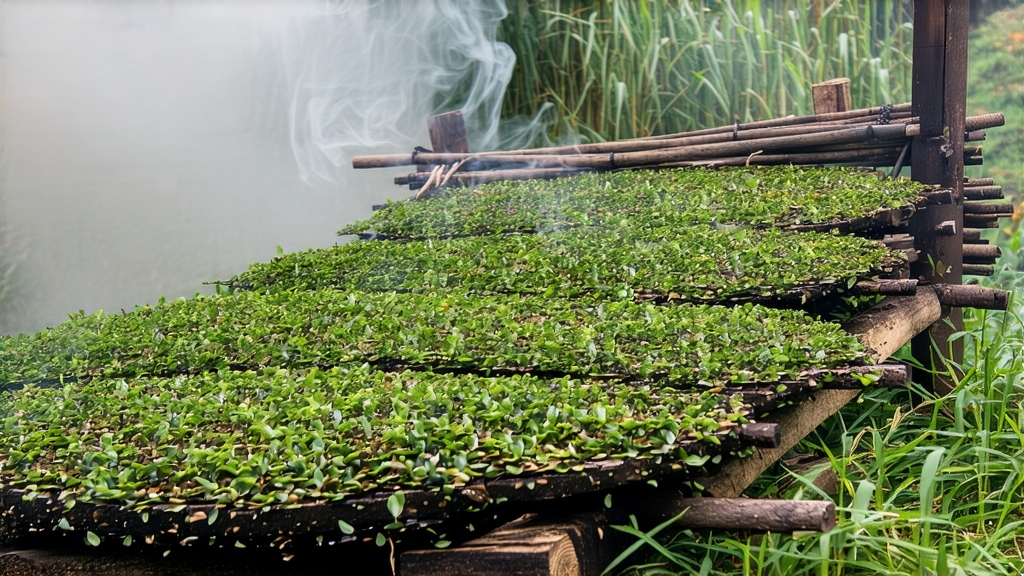
When European tea clippers first rounded the Cape of Good Hope in the mid-seventeenth century, the chests that commanded the highest prices at the Amsterdam and London auctions bore a small, almost cryptic inscription: “Bohea Souchong.” That name—corrupted from the Fujianese place-name “Wuyi” and the Chinese term xiao zhong, “small leaf cultivar”—referred to what we now call Lapsang Souchong, the earliest intentionally crafted black tea in the world. In the mist-locked Wuyi Mountains of northern Fujian, monks and farmers had already been oxidising leaf for at least two centuries before the West ever tasted it, and the smoky twist they gave it was not a gimmick but a pragmatic solution to humid monsoon air. Today, despite a sea of modern black teas, Lapsang Souchong remains the benchmark against which connoisseurs measure the marriage of fire, forest and leaf.
History: from imperial tribute to global icon
Song dynasty records (960-1279) mention compressed “dragon-phoenix” tea cakes from Wuyi, but the first explicit reference to hong cha—literally “red tea,” what the West calls black—appears in the Ming Wanli era (1573-1620). A passing Qing army bivouacked in Tongmu village during the late spring harvest of 1646; villagers, anxious to dry leaf quickly before the soldiers requisitioned it, spread it over pine fires. The result, unexpectedly fragrant, found favour with Dutch traders at the port of Xiamen, and by 1669 the British East India Company listed “Souchon” at 28 shillings a pound, ten times the price of green tea. Catherine of Braganza’s dowry chest that same year introduced the style to the English court, sealing its reputation as the “tea of kings.” When Scottish botanist Robert Fortune infiltrated Wuyi in 1848 he carried seedlings and craft secrets to the Nilgiris and Ceylon, making Lapsang Souchong the genetic and stylistic godparent of every subsequent black tea.
Micro-terroirs: Tongmu, Guadun, Miaowan
Only 68 square kilometres of Wuyi’s core conservation zone may legally sell leaf as Zheng Shan Xiao Zhong—“Original Mountain Small Leaf.” Elevation ranges from 600 m to 1 400 m, where morning fog refracts light into a soft, bluish spectrum that slows photosynthesis and concentrates amino acids. The soil is a weathered tuffaceous rock high in potassium and manganese; roots must dive half a metre through fissures to find water, stressing the bushes into producing more aromatic volatiles. Within Tongmu, the hamlets of Guadun and Miaowan differ by slope aspect: Guadun faces east, yielding brisk, citrusy liquors, while Miaowan’s west-facing terraces give deeper, resinous cups. Such nano-distinctions are treasured by local tea masters who blend village lots the way a vintner marries crus.
Cultivars: beyond the ubiquitous “small leaf”
Although the original population is the Wuyi Caicha group (mixed seed-grown bushes with leaves barely 3 cm long), clonal selections have emerged. Wuyi Qizhong (a 1958 selection) offers thicker cell walls that withstand heavy withering, while the newer Zhenfeng 2 hao, bred for honeyed aromatics, is gaining traction among boutique producers. Purists insist that only seed-grown, 40-year-old bushes produce the elusive “longan and lychee” finish, yet modern plantings guarantee consistency for export grades. The compromise is to graft old-tree scions onto vigorous rootstock, preserving flavour while tripling yield.
Craft: the four pillars of pine-smoke alchemy
- Pluck: one bud and two leaves, picked between Qingming and Grain Rain when saponin levels are lowest, ensuring no grassy bitterness.
- Wither: 8–10 h on bamboo racks suspended over a slow, smokeless charcoal fire held at 28 °C; moisture drops to 60 % while enzymatic activity primes the leaf for oxidation.
- Roll & oxidise: 70 min of light rolling ruptures 30 % of cells; leaf is then heaped in pine-wood crates where temperature climbs to 24 °C and humidity to 85 %. Catechins oxidise into the